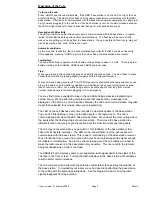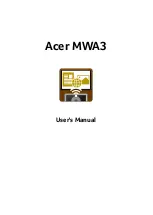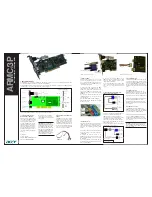
About your wireless adapter:
The RU01-Pro is designed to eliminate the need for tethered operation of an NCE Cab. All
present and planned features of the cab are usable while untethered from the cab bus. The
adapter is battery powered and will supply power for both cab operation and the adapter
itself. Although the RU-4/5 adapter is designed to operate at any voltage from 2 to 16 volts
we recommend the use of 2 AAA cells. The transmitter power of the RU-4/5 is .00025
Watts. By comparison your cell phone can put out 3 Watts or 12,000 times the power of
the RUCab. For this reason a general discussion of wireless communications follows.
Wireless communications:
We are continuously asked about the operating distance of the wireless cab. There are
many factors governing the useful range of wireless products. The RU-4/5 operates in the
ISM (Industrial, Scientific and Medical) radio band at 916.5 MegaHertz (Mhz). Many
cordless phones, wireless computer networks, home automation systems, and wireless
security devices also operate in this portion of the radio band and all contribute to radio
interference. In any radio system, propagation of the radio signal will suffer in the presence
of ‘in band’ intererence. When devices operate in the same frequency band they may
contribute interference to the point where your cab may not work at all. On the other hand
your wireless cab may interfere with the operation of the other devices you already own.
Radio waves are like one big telephone ‘party line’ where everyone is talking at once. A
device using these radio waves must attempt to sort out what ‘voices’ are relevant to its
operation and which ones are ‘noise’. If there is too much noise it can’t do this
successfully and will operate poorly or not at all.
Indoor radio propagation is an issue for special consideration. The human body readily
absorbs RF energy in the frequency band used by the RU-4/5 cab radio. Placement of the
base station can mitigate blocking of the radio signal due to human body absorption. In
most indoor situations ‘dead spots’ can be found where reception is very difficult. These can
occur even if there appears to be a direct line of sight between the transmitter and receiver.
These dead spots, or ‘nulls’, are the result of multiple radio transmission paths between two
points caused by reflections off metal objects such as steel beams, screen wire, concrete
rebar, metal door and window frames, ceiling tile frames, model railroad track, etc. Nulls
occur where the path lengths differ by an odd ½ wavelength (about 6 inches at 900 MHz).
Deep nulls are usually very localized and can be avoided by moving slightly, usually only a
few inches. On occasion, when performing complex tasks communications between the
cab and command station may take longer than expected thus slowing down your loco or
macro selection. In these instances you may find it more expedient to plug in the cab.
The transmitter power of the RU-4/5 is .00025 Watts. By comparison your cell phone can
easily put out 3 Watts or 12,000 times the power!
Pre-installation checkout:
Before beginning installation of the RU-4/5 it is best to ensure that your Cab is within the
specified range of addresses for wireless operation. Your CAB04/05 must be in the range of
19 to 50 for proper operation with the RB01 base station. To set the cab address of your
CAB04/05: unplug it from the operating cab bus, hold down the “SEL LOCO” button while
plugging in the cab. Type in the 100 PLUS the desired cab address (example: for Cab
address 22 put in 122) followed by “ENTER”. The cab should now be set to the new
address. Make sure it operates properly then unplug it so installation can begin. If you
have an older version of the CAB04 or CAB05 with the internal DIP switch for the cab
address consult you cab manual for adressing instructions.
**Last revised: 21 February 2002
Page 2
RU-4/5


























